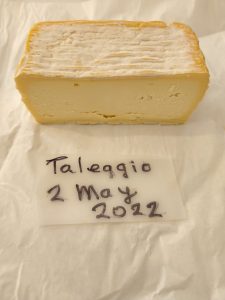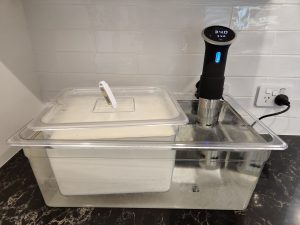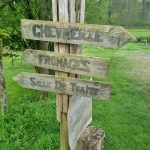When did you take up cheesemaking and why?
Nine years ago (2013), our local evening college advertised a cheese-making course that would be run at our local high school on a Saturday. I have always enjoyed eating cheese and have recently been inspired by Will Studd’s Cheese Slices (both the TV episodes and his book of the same name). As my curiosity aroused, I enrolled in the course.
Two months later, a more advanced cheesemaking course, again on a Saturday at our local high school. After these two courses, I was hooked on making cheeses at home!
What was the first batch of cheese you made by yourself at home? How did you feel about the experience and how did the cheese turn out? Can you compare your experience between then and now?
My first homemade cheese was fetta, made from the course recipe. The first time it was served on a salad was very exciting, but the excitement was somewhat dampened when the tasting panel (my immediate family) pronounced it too salty! I have since cut down on the salt!
The biggest difference between then and now is that then I followed each recipe literally without question, having no knowledge or experience to contribute. In contrast, I can now read between the lines of recipes, interpreting their intent in the context of what is and is not possible in our home kitchen.

What sort of cheeses (& dairy products eg yoghurt) do you make, how many times have you made cheese, why do you like making cheese and how often do you make it?
My current routine is to make yoghurt and ricotta as required; fresh chèvre and St Maure every week or so. Depending on the availability of goat milk from Harris Farm; a Taleggio and two White moulds every two weeks or thereabouts. And a pair of larger cheeses (chosen from Asiago, Canestrato, Comté, Stilton, Shropshire, Cheshire) every couple of months or so, when I get a home delivery of 16 litres of milk. Occasionally I make Robiola, Halloumi, Paneer, Feta, and (for guests) Crescenza.

What have been some interesting or rewarding cheesemaking experience/s
Every time I make cheese at home is interesting and rewarding! The interest comes from repeatedly being reminded of how natural processes can be harnessed to such great ends! And the reward comes days or months later when those ends can be shared with family and friends. Also, I find it enormously satisfying to know that in making cheese from milk, I am doing what humans have been doing for thousands of years.
What has been your biggest cheesemaking challenge/s
By far the biggest challenge has been, and still is, affinage in our home kitchen! Even though I have graduated from an esky to a wine fridge as my cheese cave, I still struggle with unwanted microbial contamination and with humidity (too high or too low).
The contamination problem has largely been resolved by vacuum sealing, which has been a revolution for me. But contamination is still a problem, especially for fresh chèvre. And getting the humidity right, e.g. for Taleggio and White mould, is still a major challenge for me. Oh, and my most recent batch of halloumi melts at the slightest hint of heat!
What is your favourite cheese(s) to make?
I love the idea of a washed rind. For many years, my favourite cheese was Epoisses, washed with Marc de Bourgogne. But when Covid came along, supplies of Marc de Bourgogne dried up! This forced me to switch to Taleggio, washed with a Brevi linens solution.
My washing procedure with Marc de Bourgogne is:
I diluted it 1:1 with water, and washed with a cloth every second day. Turning every day roughly from day 5 to day 21.
What cheese do you regularly have in your fridge OR What cheese cannot you do without
We always have grana padano in our fridge at home, and I have never made this, largely because I don’t have the patience, nor the affinage capacity, to do justice to it.
My advice to anyone looking to start out on a cheesemaking journey?
Attend one of Graham Redhead’s courses! I can’t recall how I first heard of Graham Redhead and his courses. But I learned so much when I attended his two Intensive Cheesemaking Courses in Sydney in 2015 and 2017.
For anyone reading this, the same courses are offered regularly in Perth, Melbourne, Canberra and Brisbane, as well as Sydney. I was overjoyed to receive a text with photos from our niece at a Graham Redhead course in Brisbane, the result of my suggestion.
My main sources are Graham Redhead’s course notes and also Jim Wallace’s cheesemaking.com.
My favourite cheese(s) and cheese pairing(s)
Currently, my oldest home made cheese is a 19-month-old canestrato, which was vacuum packed around 6 months ago. It should be a perfect fit with a Rutherglen Muscat.
At the other end of the age scale, a fresh St Maure goes very well with a good white. Such as a pinot gris from Andrew Pirie’s Apogee vineyard and winery in Tasmania.
What cheese do you want to make but have not made?
I’m keen to try a Gouda, and am in the process of combining several recipes.
Do you have any equipment you like to use at home?
My favourite equipment is a sous vide apparatus which has revolutionised my making of 8 and 12 litre cheeses. Placed in one of Graham Redhead’s 24-litre vats, the sous vide machine provides ideal temperature control for my batches. I would be lost without it.
Is there a favourite book or resource that you reference most to get technical information?
One of my first cheese books inspirations has been Nick Haddow’s Milk Made, and two DK books, French Cheeses and World Cheese Book. My go-to resources for written information on actual cheese-making are Graham Redhead’s web notes and course notes and Jim Wallace at cheesemaking.com.
Do you have food-related hobbies outside of cheese, we all like these sorts of foods so include references and images of them also.eg sausages, small goods, meats, wine, bread, jams, chutneys, cakes that you love making at home?
During my very first cheese-making course, another attendee told me about a New York Times recipe for no-knead bread. I tried this, and was hooked again, this time with baking bread.
Since then, I have experimented with a range of kneading recipes, ending up with (at present) a fortnightly sourdough white/wholemeal/rye conglomerate. Which is inspired by Maurizio Leo’s The Perfect Loaf website and a weekly white flour baguette inspired by a marvellous John Kirkwood video.
I have also greatly enjoyed making a Pompeii loaf, inspired (via the British Museum) by Giorgio Locatelli. A great family hit is Nick Haddow’s lavosh, from Nick’s book Milk Made. Another family hit are the cheese sticks that Charles Darwin used to eat, made to a recipe from Mrs Charles Darwin’s Recipe Book.
Yet another family favourite are Melba toasts, made from the original Hotel Savoy recipe.










